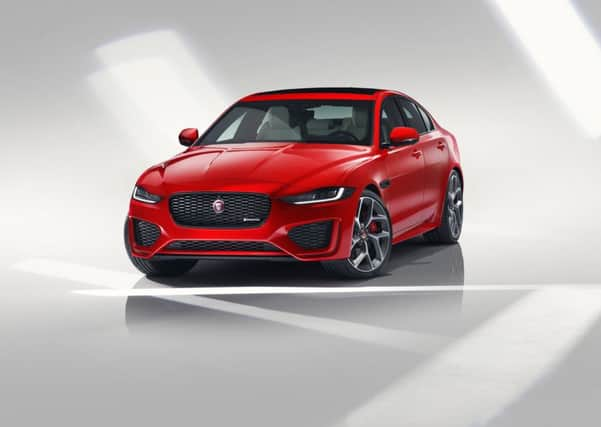Jaguar XE sports saloon


Inside an XE is where it’s at, setting a Jaguar apart from opportunist marques. There are fine leather seats with lots of powered settings in the front, a scarcity of hard plastics and so on. The rear seats, fixed on the test car, had a fold-down central arm rest. The ivory and ebony leather trim looked splendid.
In this mid-life revision there’s a gear sector lever rather than a rotary dial. Soundproofing has been improved. A sleeker face is achieved by changing the shape of the front grille and the headlamps. There has been a cosmetic re-jig at the back including a lip which has been stuck on the boot edge. It no doubt adjusts the airflow at high speed but it is a visual disruption and cheapens the look.
Advertisement
Hide AdAdvertisement
Hide AdThe equipment level is good. All models have an 8-speed automatic gearbox, 2-litre turbo engines and £33,915 or thereabouts buys the 245.5bhp XE 250S with rear-wheel-drive and automatic gears. Rated at 0-62 mph in 6.5 seconds it is more than fast enough for anywhere in Britain. It is also a drinker, rated at 33 to 36mpg and 159g of CO2.
You may be inclined to keep faith with diesel and its economy. Just one option here, the 177.5bhp D180 from £34,555 in S level trim, rated at 46 to 50mpg, 130g and 0-62mph in 8.1 seconds.
Jaguar sent us the third engine option, the exciting XE 300 petrol, with 296bhp and all-wheel-drive, from £39,415. A 5.7 seconds 0-62 time puts it well up the grid, tempered by an official 30 to 33 mpg and 167g of CO2. Of interest, despite its sexy bhp, it hasn’t got as much torque as the diesel engine, with 295lb ft versus 317lb ft. That’s another tick for the diesel.
The D180 looks the smart buy, and you can have it with AWD from £36,415. However, beggars were not to be choosers on this occasion so I spent the week working on the economy of the XE300 – all the D180s being otherwise booked out.
There’s not much point prattling about the need for economy rather than dramatic acceleration these days. Anyone driving anywhere knows the futility of fast driving. You gain B-all and run the risk of speed traps and fuel poverty. I gave the XE300 a tentative push and too quickly was heading for trouble.
Jaguar speed limiters can be set to react to speed limit signs but I never found the system so had to be on full alert for those quirky changes in speed limits which often seem illogical and bait for speed cameras. The Jag had a camera blipper as well. So, all being well…
I drove it to Ullswater in the northern Lake District to see, with the latest Land Rover Discovery Sport – which shares some of the XE engines. Between you and me I preferred driving the Land Rover. SUVs give better visibility on country roads with walls and hedges and blind summits and the ride comfort is kinder.
The sensible 18-inch alloys had been replaced with street-cred 20-inch rims. These £900 eye-catchers were on 265/30 Pirelli P Zero at the back and 235/35 at the front. It is not a combination you’d want on poor surfaces. One lateral ridge – so subtle I never saw it – caused a whack which felt as if those wide, shallow tyres were flat. That occurred with the car on its “comfort” setting.
Advertisement
Hide AdAdvertisement
Hide AdThat said, the X has to remain a “driver’s car” to be a true Jaguar and a decent alternative to the German hierarchy. BMW’s 3-series, the Audi A4 and the Mercedes-Benz C-class are convincing rivals with sales far exceeding Jaguar Land Rover combined, and now Volvo has muddied the choice with its petrol-only S60 and super quick T8 hybrid.
It is a pity that diesel engines have become the dirty man of Europe. The modern diesel gives lovely performance with decent economy. High performance petrol cars are thirsty. Jaguar is not alone. Unless you are wealthy or have a company fuel card or lenient expenses you’ll shy away from petrol.
Jaguar has started its electric vehicle programme with the marvellous I-Pace SUV. More electrified Jaguars will follow. Unfortunately the system for charging your car at public locations is often laborious and, at its best, takes much longer than liquid refuelling.
Future Jaguars are being created at the company’s new design studio, bringing the entire team (now 280) into one place for the first time in the marque’s 84 years. Its director, Julian Thomson, says it is the most advanced automotive design centre in the world, developed to enhance the human creative design process with world-leading technologies. No excuses for failure, then.
Verdict: Lonely Brit up against the German and Swedish opposition.